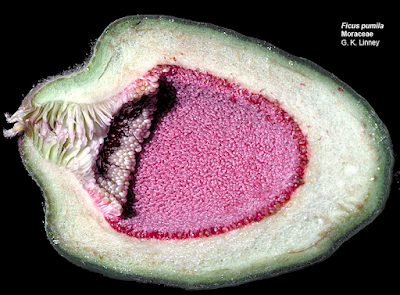
 With a few minutes to spare, which is largely an illusion, so let's say, while wasting a few minutes, TPP stepped into our teaching greenhouse a few short steps from his botany classroom to inhale humid air laden with the smell of luxuriant plant growth. Especially in the winter this is great therapy. And there on the floor was a strange, slightly bell-shaped, and for an indoor plant, unusual fruit upon the floor beneath a potted banana (no, clearly not a banana), which was under a Gnetum (which is a gymnosperm, so quite impossible as a fruit producer although it does have a somewhat fleshy seed coat), and so further up was the source. The entire north end of our glasshouse is home to a quite large fig, the creeping fig, Ficus pumila. Although rather hard to find and seldom noticed the trunk of this vertically sprawling/climbing fig is about 15 cm in diameter. And most certainly the fruit was an immature fig syncomium. This is a tough fruit to understand, and a tough one to explain (TPP has tried before). OK, lets start with a strawberry. The fleshy "fruit" is the receptacle (an accessory fruit) and the many pistils of the strawberry flower form fruitlets, little achenes on its surface. Now if instead of achenes they were drupelets like in raspberries, and if instead of being individual pistils in a single flower they were each a flower, and instead of being bisexual as in the strawberry, the flowers were unisexual, and if the entire thing were then turned inside out, well, simple as that, you'd have a syncomium. The fleshy outer wall is the receptacle, and on the inner facing wall are unisexual flowers, whitish, male pollen-producing flowers just below the apex (although the syncomium is often pendant) and below them reddish female fruit-producing flowers (Thanks to Gerry Carr for posting this image). Each fig is pollinated by a species of wasp that requires the fig as a location for mating and rearing its young, and enclosed the way they are, figs also need this particular pollinator, producing an obligate mutualism. Here's a link to this interaction diagrammed. Female wasps carrying pollen enter through the apical pore (left) where the inward orientation of bracts prevents leaving. The next generation of female wasps require males, who never leave the syncomium (try not to think about this too much when eating your next newton) to chew an exit through the syncomium wall. See, time well wasted.
With a few minutes to spare, which is largely an illusion, so let's say, while wasting a few minutes, TPP stepped into our teaching greenhouse a few short steps from his botany classroom to inhale humid air laden with the smell of luxuriant plant growth. Especially in the winter this is great therapy. And there on the floor was a strange, slightly bell-shaped, and for an indoor plant, unusual fruit upon the floor beneath a potted banana (no, clearly not a banana), which was under a Gnetum (which is a gymnosperm, so quite impossible as a fruit producer although it does have a somewhat fleshy seed coat), and so further up was the source. The entire north end of our glasshouse is home to a quite large fig, the creeping fig, Ficus pumila. Although rather hard to find and seldom noticed the trunk of this vertically sprawling/climbing fig is about 15 cm in diameter. And most certainly the fruit was an immature fig syncomium. This is a tough fruit to understand, and a tough one to explain (TPP has tried before). OK, lets start with a strawberry. The fleshy "fruit" is the receptacle (an accessory fruit) and the many pistils of the strawberry flower form fruitlets, little achenes on its surface. Now if instead of achenes they were drupelets like in raspberries, and if instead of being individual pistils in a single flower they were each a flower, and instead of being bisexual as in the strawberry, the flowers were unisexual, and if the entire thing were then turned inside out, well, simple as that, you'd have a syncomium. The fleshy outer wall is the receptacle, and on the inner facing wall are unisexual flowers, whitish, male pollen-producing flowers just below the apex (although the syncomium is often pendant) and below them reddish female fruit-producing flowers (Thanks to Gerry Carr for posting this image). Each fig is pollinated by a species of wasp that requires the fig as a location for mating and rearing its young, and enclosed the way they are, figs also need this particular pollinator, producing an obligate mutualism. Here's a link to this interaction diagrammed. Female wasps carrying pollen enter through the apical pore (left) where the inward orientation of bracts prevents leaving. The next generation of female wasps require males, who never leave the syncomium (try not to think about this too much when eating your next newton) to chew an exit through the syncomium wall. See, time well wasted.
















1 comment:
Fresh figs: 1.7 g protein per 8 oz serving
Yummy.
Post a Comment